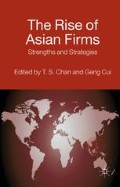Abstract
Existing findings on the internationalization of firms have largely been based on studies of firms from developed economies, following the knowledge-development process model of increasing commitment from export to foreign direct investment, and emphasizing firm-specific advantages and outward activities (Johanson & Wiedersheim-Paul, 1975). Such studies are, however, less informative about how firms generate competitive advantages in the first place. Studies that have examined the role of inward activities in firms’ internationalization suggest that firms can be integrated into the global economy through inward activities (Loustarinen & Welch, 1997; Welch & Loustarinen, 1993) or upstream internationalization (Kuada & Sorensen, 2000). Inward activities play an important role in the internationalization process of firms, particularly for firms from emerging market economies, such as China, where many firms start the internationalization process by becoming customers or joint venture partners of foreign multinationals. Thus, inward activities provide an alternative approach to beginning the internationalization process.
Access this chapter
Tax calculation will be finalised at checkout
Purchases are for personal use only
Preview
Unable to display preview. Download preview PDF.
References
Anderson, O. (1997). Internationalization and market entry mode: A review of theories and conceptual frameworks. Management International Review, 37(2): 27–42.
Barney, J (1991). Firm resources and sustained competitive advantage. Journal of Management, 17: 99–120
Bjorkman, I. & Kock, S. (1997). Inward international activities in service firms - illustrated by three cases from the tourism industry. International Journal of Service Industry management, 8(5): 362–376.
Child, J. & Rodrigues, S. B. (2005). The internationalization of Chinese firms: A case for theoretical extension? Management and Organization Review, 1(3): 381–410.
Chaudhry, S. & Crick, D. (2002). A research policy note on UK government support and small firms’ internationalization using the Internet: The Use of www.tradeuk.com. Strategic Change, 11(2): 95–104.
Cohen, W. M. & Levinthal, D. A. (1990). Absorptive capacity: A new perspective on learning and innovation. Administrative Science Quarterly, Special Issue: Technology, Organizations and Innovation, 35(1): 128–152.
Comtex News Network (2005). TCL to Expand Overseas Market with CNY8bn Loans from CDB, Inc. 10 August. www.comtex.com.
Deng, P. (2004). Outward investment by Chinese MNCs: Motivations and implications. Business Horizons, 47(3): 8–16.
Dunning, J. H. (2003). Some antecedents of internalization theory. Journal of International Business Studies, 34(2): 108–115.
Elango, B. (2001). An exploratory study into the linkages between corporate resources and the extent and form of internationalization of US firms. American Business Review, 18(2): 12–26.
Freeman, S., Edwards, R., & Schroder, B. (2006). How smaller born-global firms use networks and alliances to overcome constraints to rapid internationalization. Journal of International Marketing, 14(3): 33–63.
Hitt, M. A., Bierman, L., Shimizu, K., & Kochhar, R. (2001). Direct and moderating effects of human capital on strategy and performance in professional service firms: A resource-based perspective. Academy of Management Journal, 44(1): 13–28.
Johanson, J., & Vahlne, J.-E. (1977). The internationalization process of the firms - A model of knowledge development and increasing foreign market commitments. Journal of International Business Studies, 8(1): 23–32.
Johanson, J., & Wiedersheim-Paul, F. (1975). The internationalization of the firm: Four Swedish cases. Journal of Management Studies, 12(3): 305–322
Karlsen, T., Silseth, P. R., Benito, G. R. G., & Welch, L. S. (2003). Knowledge, internationalization of the firm, and inward-outward connections. Industrial Marketing Management, 32(5): 385–396.
Kuada, J., & Sørensen, O. J. (2000). Internationalisation of Companies from Developing Countries. New York: The Haworth Press Inc.
Liu, H. & Li, K. (2002). Strategic implications of emerging Chinese multinationals: The Haier case study. European Management Journal, 20(6): 699–709.
Luostarinen, R. & Welch, L (1997). International Business Operations. Helsinki: Helsinki School of Economics, 3rd ed.
Mathews, J. A. (2006). Dragon multinationals: New players in the 21st century globalization. Asia Pacific Journal ofManagement, 23(1): 5–27.
Peng, M. W. (2003). Institutional transitions and strategic choices. The Academy of Management Review, 28(2): 275–296.
Pfeffer, J. M. & Salancik, G. R. (1978). The External Control of Organizations: A Resource Dependence Perspective. New York: Harper & Row.
Sim, A. B. & Pandian, J. R. (2003). Emerging Asian MNEs and their Internationalization strategies — Case study evidence on Taiwanese and Singaporean firms. Asia Pacific Journal of Management, 20(1): 27–50.
SinoCast China IT Watch (2006). Haier met losses in several sectors last year. 6 January. www.SinoCast.com.
Taylor, R. (2002). Globalization strategies of Chinese companies: Current development and future prospects. Asian Business & Management, 1(2): 209–225.
Vernon, R. (1966). International investment and international trade in the product cycle. Quarterly Journal of Economics, 80(2): 190–207.
Welch, L. S. & Luostarinen, R. K. (1993). Inward-outward connections in inter-nationalization. Journal of International Marketing, 1(1): 44–56.
Wells, L. T., Jr. (1983). Third World Multinationals, Cambridge, MA: MIT Press.
Young, S., Huang, C.-H. & McDermott, M. (1996). Internationalization and competitive catch-up processes: Case study evidence on Chinese multinational enterprises. Management International Review, 36(4): 295–314.
Zeng, M. & Williamson, P. J. (2003). The hidden dragons. Harvard Business Review, 81(10): 92–99.
Editor information
Editors and Affiliations
Copyright information
© 2014 Geng Cui, T. S. Chan, Hua Zhang and Ling Peng
About this chapter
Cite this chapter
Cui, G., Chan, T.S., Zhang, H., Peng, L. (2014). Different Roads to Rome? Patterns of Internationalization in Chinese Firms. In: Chan, T.S., Cui, G. (eds) The Rise of Asian Firms. The AIB Southeast Asia Series. Palgrave Macmillan, London. https://doi.org/10.1057/9781137407719_9
Download citation
DOI: https://doi.org/10.1057/9781137407719_9
Publisher Name: Palgrave Macmillan, London
Print ISBN: 978-1-349-48820-9
Online ISBN: 978-1-137-40771-9
eBook Packages: Palgrave Business & Management CollectionBusiness and Management (R0)

